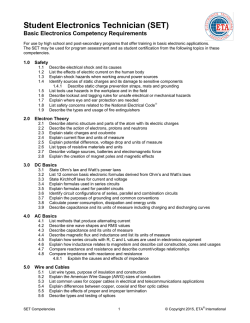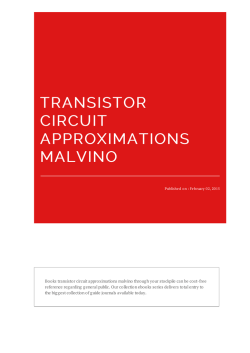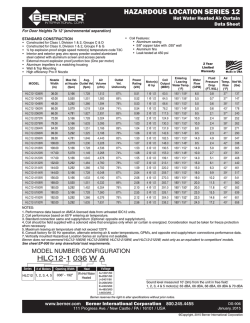
Evolution of analog circuits on Field Programmable
Evolution of analog circuits on Field Programmable Transistor Arrays A. Stoica, D. Keymeulen, R. Zebulum, A. Thakoor, T. Daud, G. Klimeck, Y. Jin, R. Tawel and V. Duong Jet Propulsion Laboratory California Institute of Technology 4800 Oak Grove Drive Pasadena, CA 91 109 [email protected] Abstract Evolvable Hardware (EHW) refers to HW design and self-reconfiguration using evolutionary/genetic mechanisms. The paper presents an overview of some key concepts of EHW, describing also a set of selected applications. A fine-grained Field Programmable Transistor Array (FPTA) architecture for reconfigurable hardware is presented as an example of an initial effort toward evolution-oriented devices. Evolutionaryexperimentsinsimulationsandwitha FPTA chip in-the-loop demonstrate automaticsynthesis of electronic circuits. Unconventional circuits, for which there are no textbook designguidelines,are particularly appealing to evolvable hardware. To illustrate this situation,onedemonstratesherethe evolution of circuits implementing parametrical connectives for fizzylogics. In addition to synthesizing circuits for new functions, evolvable hardware can be used to preserve existing functions and achieve faulttolerance, determining circuit configurations that circumvent the faults and temperature effects as well. These characteristics are extremely important for enabling spacecraft to survive harsh environments and to have long life. Expanding reconfiguration to other types of spacecraft hardware (i.e. optics, MEMS, etc) could lead to evolvable spacesystems. This paper presents the concept of evolutionary oriented devices and describes an effort toward building these devices andan evolvable systemon a chip. A FieldProgrammable Transistor Array architecture is used as theexperimentalplatformforevolutionary experiments. The platformis quite flexible and supports implementation of bothanaloganddigital circuits. While previous works [l], [2] illustrated the implementation of several conventional building blocks for electronic circuits such as logical gates, transconductanceamplifiers, filters, gaussianneuron, etc., thispaper illustrates theautomaticdesignofthe rathermoreunconventional circuits for combinatorial fuzzy logics. The paper is organized as follows: Section 2 presents thecomponents of an evolvable hardwaresystem, providing a perspectiveontheevolutionofthe field. Section 3 surveys some important evolutionary experiments and applications of evolvable hardware. Section 4 presentsan evolution-oriented architecture based on the concept of Field Programmable Transistor Array. Section 5 illustrates how the FPTA can be used to evolve reconfigurable circuits for combinatorial fuzzy logic. Circuits implementing parametric triangular norms are evolved in software and in hardware directly on the chip. Section 6 presents considerations related to theapplicationof evolvable hardware in space systems. 1. Introduction The application of evolution-inspiredformalisms to hardwaredesignandself-configurationleadtothe concept of evolvable hardware (EHW). In the narrow sense, EHW refers to self-reconfiguration of electronic hardware by evolutionaqdgenetic reconfiguration mechanisms. In a broader sense, EHW refers to various forms of hardware from sensors and antennas to complete evolvable spacesystemsthatcouldadaptto changingenvironments and, moreover,increase their performance during their operational lifetime. 2. Evolvable hardware: from rootsto buds The mainidea of evolutionary/geneticalgorithms is inspired by the principle of natural selection. In nature the fittest individualssurviveand reproduce passing along their genetic material to their offspring, who will inherit the characteristics that made the parents successful. Similarly, the evolution of artificial systems is based on a population of competing designs, the best ones (i.e. theonesthatcome closer to meetingthe design specifications) being selected for further investigation. The offspring of this elite, in which pairs of parents were randomly selected for "mating", combine genetic material from two parents and may suffer genetic "mutations" (alternatively, in asexual reproduction the genetic code from one successful individual may be inherited, possibly with some random mutation). The offspring are the new generation of competing designs. This process of trial-and-error parallel search canlastmany generations, andcanbe constructed withmany choices onhow to implement reproduction, selection, etc. Evolvable Systems solutions willbecome an integrated component in a variety of systemsthatwillthushave an evolvable feature. Figure 2 illustrates themain steps of evolutionary design for electronic circuits. Each candidate circuit design is associated with a "genetic code" or chromosome. The simplest representation of a chromosome is a binary string, a succession of Os and 1s that encode a circuit. The first step of evolutionary synthesis is to generate a random population of chromosomes. The chromosomes are then converted into a modelthat gets simulated (e.g. by a circuit simulator such as SPICE) and produces responses that are compared against specifications. Chromosomes Board level evolutim Figure 2 Evolutionary synthesis of electronic circuits Figure 1 Evolutionary path for the evolvable hardware field: from design optimization to hardware IP cores for evolvable systems. The concept of evolvable hardware was born partially inspired by the search/optimization/adaptation mechanisms and partially by the availability of reconfigurable devices such as Field Programmable Gate Arrays (FPGA). Circuits can be evolved reconfiguring programmable devices (which is called intrinsic EHW) or evolving software models descriptions of the electronic HW (referred to as extrinsic EHW). Currently, evolutionary platforms are board level. These include programmable hardware that is reconfigured under the control of configuration bits determined by evolutionary algorithms running in software. It is likely that in the next 1-3 years, a number of platforms will integrate the reconfigurable hardware andthe reconfiguration mechanisminan evolvable system-on-a-chip (SOC) solution. Finally, the path leads to the Intellectual Property (IP) level and EHW A solution determined by extrinsic evolution may eventually be downloaded or become blueprint for hardware. In intrinsic evolution the chromosomes are converted into control bitstrings, which are downloaded to program the reconfigurable device. The configuration bitstring determines the functionality of the cells of the programmable device and the interconnection pattern between cells. Circuit responses are compared against specifications of a target response and individuals are ranked basedonhow close they come to satisfying it. Preparation for a new iteration loop involves generation of a new population of individuals from the pool of the best individuals in the previous generation. Here, some individuals are taken as they were and some are modified by genetic operators, such as crossover and mutation. The process is repeated for a number of generations, resulting in increasingly better individuals. The process is usually ended after a given number of generations, or when the closeness to the target response hasbeen reached. In practice, one or several solutions may be found among the individuals of the last generation. 3. Evolutionary Experiments A variety of circuits havebeen synthesized through evolution. For example, Koza used Genetic Programming (GP) to grow an “embryonic” circuit to one that satisfies desired requirements [4]. This technique wasusedto evolve a variety of circuits, ranging from filters to controllers. Some of Koza’s evolved designs rediscover solutions that at some point in time were patented, illustrating thus the power of the GP to obtain solutions that normally require an intelligenthnnovative human. Some researchers succeded evolution in hardware. For example, evolution in hardware was demonstrated by Thompson [5], who usedanFPGA as the programmable device, and a Genetic Algorithm (GA) as the evolutionary mechanism. Higuchi and colleagues in Japan have used evolvable hardware for a variety of applications, the most recent including the use of EHW to increase the yield of specific chips. In particular, the technique is applicable to chips withvery tight requirements and which are fabricated in a relatively new technology which still has poor yield. For example, the technique was used to automatically tune (and thus bring to specs and pass the tests increasing the yield) filter chips for cellular phones andto compensate for clock skew of fast processors. More details on current work in evolvable hardware can be found in [6] and [7]. Evolutions of analog circuits reported in [4] were performed in simulations, without concern for a physical implementation, but rather as a proof-ofconcept to show that evolution can lead to designs that compete with human designs, or even exceed them in performance. Current programmable analog devices are very limited in capabilities and do not support the implementation of the resulted design (but, in principle, one can test their validity in circuits built from discrete components, or anin ASIC). More recently, evolutionary experiments were performed on commercial Field Programmable Analog Arrays (FPAA) and custom-designed ASIC. Figure 3 illustrates a plethora of devices platforms that were used for EHW experiments. The hardware devices include FPGAs, FPAAs, Analog ASICs, etc. ~ FPAA Functional Figure 3 Multitude of platforms for EHW experiments 4. Toward Evolution-Oriented Reconfigurable Architectures Current efforts toward hardware evolution havebeen limited to simple circuits. In particular for analog circuits, this limitation comes from a lack of appropriate reconfigurable analog devices to support the search. This precludes searches directly in hardware and requires evolving on hardware models. Such models require evaluation with circuit simulators such as SPICE; the simulators need to solve differential equations and, for anything beyond simple circuits, they require too much time for practical searches of millions of circuit solutions. A hardware implementation offers a big advantage in evaluation time for a circuit; the time for evaluation is determined by the goal function. For example, considering an A D converter operating at a 1 0 0 kHz sampling rate, its electronic response is available within 10 microseconds, compared to (an over-optimistic) 1 second on a fast computer running Spice; this advantage increases with the complexity of the circuits. In this case the lo4 speedup would allow evaluations of populations of millions of individuals in seconds instead of days. Increasingly more complex Field Programmable Devices (FPGA, FPAA, etc) offer powerful solutions to applications in digital signal processing, programmable interfaces, filtering, etc. However, for efficiency in EHW applications, future devices would benefit from implementing evolution-oriented reconfigurable architectures (EORA). One of the most important features for EORA relates to the granularity of the programmable chip. FPAA offer only coarse granularity which isa clear limitation; FPGAs are offeredbothin versions with coarse grained and fine grained architectures (going to gate level as the lowest level of granularity). From the EHW perspective, it is interesting to have programmable granularity, allowing the sampling of novel architectures together with the possibility of implementing standard ones. The optimal choice of elementary block type and granularity is task dependent. At least for experimental work in EHW, it appears a good choice to build reconfigurable hardware based on elements of thelowestlevel of granularity. Virtual higher-level building blocks can be considered by imposing programming constraints. An example of this would entail forcing groups of elementary cells to act as a whole (e.g. certain parts of their configuration bitstrings with the interconnections for the N transistors implementing a NANDwouldbe frozen). Ideally, the “virtual blocks” for evolution should be automatically definedklustered during evolution (an equivalent of the AutomaticallyDefined Functions [9] predicted and observed in software evolution). EORA shouldbe transparentarchitectures, allowing theanalysisandsimulation of the evolved circuits. They should also be robust enough not to be damaged by any configuration existent inthe search space, potentially sampled by evolution. Finally EORA should allow evolution of both analog and digital functions. An evolvable system-on-a-chip architecture is suggested in Figure 4. The main components are a Field Programmable Transistor Array and a Genetic Processor. The idea of a field programmable transistor array was introduced in [8] as a first step toward EORA. The FPTA is a concept design for hardware reconfigurable at transistor level. As both analog and digital CMOS circuits ultimatelyrelyon functions implementedwith transistors, the FPTA appears as a versatile platform for the synthesis of both analog and digital (and mixed-signal) circuits. The architecture is cellular, and has similarities with other cellular architectures as encountered in FPGAs (e.g. Xilinx X6200 family) or cellular neural networks.Onekey distinguishing characteristic relates to the definition of the elementary cell. The architecture is largely a “sea of transistors” with interconnections implemented by other transistors acting as signal passing devices (gray-level switches), and with islands of RC resources in between. Figure 5 illustrates a FPTA cell consisting of 8 transistors and 24 programmable switches. The status of the switches (ON or OFF) determines a circuit topology and consequently a specific response. Thus, the topology can be considered as a function of switch states, and can be represented by a binary sequence, such as “101 l...”, where by convention one can assign 1 to a switch turned ON and 0 to a switch turned OFF. Programming the switches ONand OFF defines a circuit for which the effects of non-zero, finite impedance of the switches can be neglected in the first approximation (for low frequency circuits). Figure 4 An evolvable SOC s7 53 SI 1 520 Figure 5. Module of the Field Programmable Transistor Array The status of the switches (ON or OFF) determines a circuit topology and consequently a specific response. Thus, the topology can be considered as a function of switch states, and can be represented by a binary sequence, such as “101l...”, where by convention one can assign 1 to a switch turned ON and 0 to a switch turned OFF. Programming the switches ON and OFF defines a circuit for which the effects of non-zero, finite impedance of the switches can be neglected in the first approximation (for low frequency circuits). 5. Evolving reconfigurable circuits fuzzy logics for This section illustrates the evolutionary design of infinitesimal multi-valued logic circuits, more precisely circuits for fuzzy logics. The objective is to determine circuit implementations for conjunctions and disjunctions for fuzzy logics. In such logics, conjunction and disjunction are usually interpreted by a T-norm and by its dual T-conom ( S - n o m )respectively. A function T: [0,1] x [0,1] => [0,1] is called a triangular norm (T-norm for short) if it satisfies the following conditions: associativity (T(x,T(y,z)) = T(T(x,y),z)), 0 commutativity (T(x,y) = T(y,x)), 0 monotonicity (T(x,y) I T(x,z), whenever y I z), and boundary condition (T(x,l) = x). A function S: [0,1] x [0,1] => [0,1] is called a triangular conorm (T-conorm or S-norm for short) if it satisfies the conditions of associativity, commutativity, monotonicity,andtheboundary condition S(x,O) = x. S and T are corresponding (or pairs) if theycomply withDe Morgan’s laws.Frank’s parametric T-norms and T-conorms (also refered to as fundamental Tnorms/conorms in [9]) werethe selected choice for modeling the logical connectives. The family of Frank T-norms is given by if ( s = 0 ) if ( s = 1) The family of Frank T-conorms is given by Electronic circuits implementingthe above equations in implementations of fuzzy logic can be used computations or in implementingfuzzy S-T neurons. One interesting application made possible in this implementation is the selection of the most appropriate s-parameter for the application at hand. Examples of the influence of various T-norms and S-norms in fuzzy control andautomated reasoning applications canbe foundin [lo] and [ 1 11, and for learning in fuzzy neurons in [ 121. The following preliminary results illustrate the possibility of evolving circuits that implement T and S for various values of the parameter s. The circuits were powered at 5V and the signal excursion was chosen between 1V (for logical level “0”) and 4V (for logical level “I”). Intermediary values were in linear correspondence, i.e. 2.5V corresponds to logic level 0.5. etc. The experiments wereperformedboth in software (Spice simulations) andinhardwareusing2 FPTA cells. The experiments used a population size of 128 individuals, wereperformed for 400 generations (with uniform crossover, 70% crossover rate, 4% mutation rate, tournament selection) and took around 15 minutes using 16 processors when evolving in simulations. Figures 6,7,8 show the response of circuits targeting the implementation of fundamental T-norms for s=O, s=l, and s=100 respectively. The diamond symbol (0) marks points of simulated/measured response of evolved circuit, while the cross symbol (+) marks the points of an ideal/target response for the given inputs. The output (T) is mapped on the vertical axis; values on axis are in Volts. The circuit for T-norm with s=100 is shown mappedontwo FPTA cells in Figure 9. Figure 10 shows the response of the circuit implementing the fundamental S-norm for s=IOO. Figure 11 shows the diagonal cut for the same S-norm. All these responses were for circuits evolved in software; for comparison the response of a circuit evolved in hardware (for s=l) is shown in Figure 12. In this case we limited the voltage levels to the range of 2 to 3V. The Mean Absolute Percentage Error (MAPE) to the correct solution achieved 3.72%. Two FPTA cells were used in this hardware experiment. The convergence toward solution can be seen in Figure 13, where a function of the error of best individual is plotted across the number of generations. Figure 6 Simulated response of a circuit implementing fundamental the T-norm for s=O (0). Target characteristic shown with (+). x,y axis are for inputs, z (vertical) is the output, T. Axes are in Volts. Figure 8 Response of a circuit implementingthe fundamental T-norm for s=100 (0). Target characteristic shown with (+). Another way to increase the approximation power is to allow more resources, e.g. allow resources from more than 2 cells. This is similar increasing to the approximationpower of neuralnetworkswhen extra neurons are added. The described experiments do not have any parametric adjustment. The width and length of the transistor channel were considered fixed. However previous results indicate that parametric optimizationcan produce goodadjustmentsafterthe topologyhasbeendetermined [14]. This will also be possible in hardware since the new version of the chip willallowswitch-selectabletransistorswithdifferent W/L in the samecell. Figure 7 Response of a circuit implementingthe fundamentalT-normfor s=l (0). Target characteristic shown with (+). Figure 9 Evolved circuit implementing the fundamental T-norm for s=100 (with the response in Figure8). 46 Logic '1' (4vJ 4 1.2 0.8 2.8 2.4 1.6 3.2 2 34.4 6 4 x (volts) Figure 10 Response of a circuit implementing the fundamental S-norm for s=100 (0). Target characteristic shown with (+). Finally, another extrinsic experiment was performed, inwhich we allowed parametric optimization, i.e,the optimization of the width and length of the transistors channels after the topology evolution. Figure 14 shows the result for s = 1. -The performance is improved comparedto the onewithout parametric optimization (Figure 7). These results are preliminary and are presented mainly to illustrate some aspects of the application of EHW to synthesis of electronic circuits implementing combinatorial fuzzy logic functions. No comparison withany state-of-the-art design tools is made,and, of course, the performance of (computer-assisted) human solutions could exceed the performance of the totally automated solutions illustrated here. However,to the author's best knowledge, complete automated design of the type presented here is not available in anyother tool. Moreover, this author believes that completely automated techniques of the kindpresentedherewill surpass current design techniques withinthenext 5-7 years. The role of thehumanswould shift toward providing specifications and evolutionary pressures to guide the design to the desired result (which is not a trivial task). Figure 11 Diagonal cut for the response in Figure 10. Circuit implementing the fundamental S-norm for s=lOO. Target characteristic shown with fullline. Figure 12 Measured response of a hardware-evolved circuit implementing the fundamental T-norm for s=l(O). Target characteristic shown with (+). i”p s = 100 1 1 61 01 0 I 5 10 25 15 20 45 30 40 50 35 Generations Figure 13 Decreasing error between best individual in each generation and target circuit, for the three software evolved circuits, with s=O, s= 1, s= 100. Figure 14 Parametric optimization experiments: Response of a circuit implementing the fundamental Tnorm for s=l (0). Target characteristic shown with (+). 6. New FPTA Chip A new version of the FPTA chip is currently being designed. Figure 15 shows a block diagram of the future chip, which is organized as a 6x6 matrix of cells. In the new design, the cells are divided into three categories according to their relative position in the array: Boundary Cells (B); Intermediate Cells (I) and Central Cells (C). These three cell categories are similar to the topology depicted in Figure 5. -I7 B K I - C I I I I The boundary cells are in a number of 20, each of which receiving one external input. A total of 20 external inputs (I1 to120) can be applied tothe chip through 20 different pins. These inputs will be buffered and then be applied to the boundary cells. There are 12 intermediate cells whose inputs are connected to the boundary cells outputs. Finally, there are four central cells for which a more flexible interconnection pattern is allowed (thick lines in the figure). Each central cell I C - - I B T8 I Figure 15 - Block diagram of the array of reconfigurable cells for the new FPTA can connect to its West, East, CentralandNorth neighborsthrough analog multiplexers (not shown in the figure). Another important feature of the central cells is the fact that they will be the only cells in the chip with capacitance resources. On chip capacitances willembed the new FPTA withmore flexibility for filtering applications. Figure 16 displays the schematic of one central cell. Figure 16 - Schematic of the central cells. According to the schematic of figure 16, four capacitors are connected between the drain andthe gate of transistors 3,4, 5 and 6 of the cell. This positioning will allow better exploration of the Miller effect, which results in reduced sized capacitors. In addition, one programmable capacitance will also be connected to the input. A programmable capacitance is a parallel array of capacitances (around 3 of them)in series with switches. By programming the switches, we can set the overall capacitor value. This configuration was validated in simulated experiments for the evolution of bandpass filters. In one of such experiments a bandpass filter has been evolved using SPICE3 , with a freuqncy response showninFigure 17. The specification tobe met is a gain of OdB in the passing band (between 1000 and 10000 Hertz) and attenuation of 4 0 dB in the stop band (below l00Hz and above 5OkHz). The circuit netlist consisted of an arrangement of four central cells. Even though the capacitances used were in the range of nano-Farad, the circuit got close to this low frequency specification. 7. Toward Evolvable SpaceSystems EHW can bring two key benefits to spacecraft survivability. Firstly, EHW can help preserving existing functions, in conditions where hardware is subject to faults, aging, temperature drifts and radiation, etc. The environmental conditions, in particular the extreme temperatures and radiation effects can have catastrophic impacts on the spacecraft. Interstellar missions or extended missions to other planets in our solar system, with lifetimes in excess of 100 years, are great challenges on the on-board electronics. Secondly, new functions can be generated when needed (more precisely, new hardware configurations can be synthesized to provide required functionality). Figure 14 illustrates these ideas. Previous sections of thispaper illustrated how EHW can be used to automatically synthesize circuits implementing new functions. This section summarizes a fault-tolerance experiment presented in detail in [ 151. The experiment shows how EHW can recover functionality after being lost due to faults, by finding new circuit configurations that circumvent the faults. In the experiment, which targeted a circuit implementing a gaussian input-output DC response, the performance of the chip continued to bemonitoredusing the fitness function even after a solution was determined. A certain quality threshold was set. When the performance decreased below the threshold (e.g. when a fault was injected), the evolution process restarted the search for a new circuit configuration, taking into account the previous circuit configurations in the population. Faults were injected by disconnecting external wires between FFTAs. At that time a lowering of performance (but not a complete failure) was observed. The reason for the graceful degradation is that the population of circuits obtained by the evolution process contains mutants insensitive to faults having the same phenotypic effect as a genetic mutation. When the fault was injected the GA restarted with the population of its last run, which included the currently affected by fault and some of its mutants. The faulty part became just another component to beused: the evolutionary algorithm did not "know" that the part was supposed to do something else. While starting with a random population took about the sametime as finding a solution in the first place, starting with the last available population ledto recovery in about 1/3 of the time while the circuit performance recovered to 90%. Another potential area for EHW refers to the extreme temperature electronics. We present a preliminary study on the effect of changing the operating temperature for evolved circuits. We again chose the evolutionary synthesis a Gaussian circuit. Figure 17 shows the change in the response for a circuit evolved at 27' Celsius. Itcanbeverifiedfromthis figure thatthe effect of increasing temperature is to attenuate the Gaussian amplitude. The circuit behavior canbe recovered if we start a new evolutionary process, this time setting the PSPICE simulator temperature to a higher value. Figure 18 showsthe response of an evolved circuit setting the temperature to 150'C. It can beseenthat evolution produced a new circuit that recovered from the amplitude attenuation observed for the other circuits. 3.5 , Evolution of space electronics can be seen as a first step toward evolvable space systems. Evolvable hardware can be extended to include on-board sensors, antennas, mechanical and optical subsystem reconfigurable flight hardware. This has the potential to largely enhance the capabilities of future space systems. I -50°C 3 0°C 27°C New functions requirt:d for new mission phaseor 75OC 1 50'C i i I 0 0.5 1 1.5 2.5 2 3 3.5 4 4.5 5 te model of hardware is not le after launch Input (Volts) Figure 17 - Effect of increasing the temperature for an evolved circuit. Figure 19 EHW can contribute to increase spacecraft survivability and flexibility 4 7. Conclusion 0 0.5 1 1 5 2 2.5 3 35 45 4.5 Input (V) Figure 18 - Gaussian circuit evolved for 150°C. Contrastingly, has itbeen verified that a human designed Gaussian circuit is more robust than the evolved one for this range of temperatures. Notwithstanding, for extreme temperatures (higher than lSO°C), the response of human designed circuits deteriorates as well. The evolutionary approach for recovering the circuit behavior in extreme temperatures is a very promising for space applications. For instance, a potential application is for future missions to Venus, where the surface temperature is around 484°C. This paper presented some highlights in the history of the field of evolvable hardware and a possible path for its evolution in the future. It presented an effort of building evolution-oriented devices and demonstrated how electronic circuits be can automatically synthesized, on-the-chip, to produce a desired functionality. It illustrated the aspects of using evolvable hardware for the design of unconventional circuits such as combinatorial circuits for fuzzy logics. It addressed the benefits evolvable hardware may bring in flexibility and survivability of future space hardware. Acknowledgements The work described in this paper was performed at the Center for Integrated Space Microsystems, Jet Propulsion Laboratory, California Institute of Technology and was sponsored by the National Aeronautics and Space Administration and the Defense Advanced Research Projects Agency. References [ 11 A. Stoica, D. Keymeulen, R. Tawel, C. Lazaro and Wei-te Li. “Evolutionary experiments with a fine-grained reconfigurable architecture for analog and digital CMOS circuits.” In [7], 77-84 [2] R. Zebulum, A. Stoica and D. Keymeulen, “A Flexible Model of a CMOS Field Programmable Transistor Array Targeted for Hardware Evolution”, Third Int. Conference on Evolvable Systems: From Biology to Hardware (ICES2000), Edinburgh, April 17-19,2000, to appear [3] A. Fukunaga and A. Stechert, “Evolving nonlinear predictive models for lossless image compression with genetic programming Proceedings of the Third Annual Genetic Programming Conference, Winsconsin, 1998, GP-98, 434-437 [4] J. Koza, F.H. Bennett, D. Andre, and M.A Keane, “Automated WYWIWYG design of both the topology and component values of analog electrical circuits using genetic programming”, Proceedings of Genetic Programming Conference, Stanford, CA, 1996,28-31 [5] A. Thompson, “An evolved circuit, intrinsic in silicon, Conference on entwined in physics”. In International Evolvable Systems. Springer-Verlag Lecture Notes in Computer Science, 1996, 390-405 [6] M. Sipper, D. Mange, A. Perez-Uribe (Eds.) Evolvable Systems: From Biology To Hardware, Proc. oftheSecond InternationalConference, ICES 98, Lausanne, Switzerland, Springer-Verlag Lecture Notes in Computer Science, 1998. [7] A. Stoica, D. Keymeulen and J. Lohn (Eds.) Proc. of the First NASMDoD Workshop on Evolvable Hardware, July 1921, 1999, Pasadena, CA IEEE Computer Society Press. [SI Stoica, A. “Toward evolvable hardware chips: experiments with a programmable transistor array.” Proceedings of 7th International Conference on Microelectronics for Neural, Fuzzy and Bio-Inspired Systems, Granada, Spain, April 7-9, IEEE Comp Sci. Press, 1999, 156162 [9] Butnariu, D. and Klement, E. P., Triangular norm-based measures and games with fuzzy coalitions, Kluwer Academics, 1993 [lo] M. M. Gupta and J. Qi, “Design of fuzzy logic controllers based on generalized t-operators”, Fuzzy Sets and Systems, Vol. 40, 1991,473-389 [111 M.M. Gupta and J. Qi, “Theory of T-norms and fuzzy inference methods”, Fuzzy Sets and Systems, Vol. 40, 1991, 43 1-450 [ 121 Stoica, A., “Synaptic and somatic operators for fuzzy neurons: which T-norms to choose?’ In Proc. of 1996 Biennial Conference of the North American Fuzzy Information Processing Society - NAFIPS, Berkeley, CA, June 19-22, 55-58 [131 W. Wang and C. Moraga, “Design of Multivalued Circuits using Genetic Algorithms”, Proceedings 26th International Symposium onMultiple-valued 216 -221 Logic, 1996, [ 141 Stoica, A.“On hardware evolvability and levels of granularity”, Proc. of the International Conference “Intelligent Systems and Semiotics 97: A Learning Perspective, NIST, Gaithersburg, MD, Sept. 22-25, 1997 [15] A. Stoica, D. Keymeulen, V. Duong and C. Lazaro, “Automatic Synthesis and Fault-Tolerant Experiments on an Evolvable Hardware Platform”, In R. Profet et al.(eds.), Proc. of IEEE Aerospace Conf., March 18-25, 2000, Big Sky, MO, IEEE Press, to appear
© Copyright 2025




